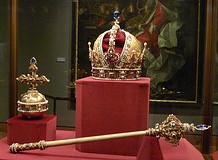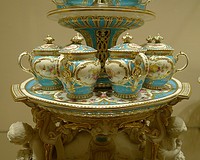



Schweizerhof
Tel. 01- 525 240
Open: 10am- 6pm Wed- Mon
Closed: Jan1, May 1, Nov 1, Dec 25
Schatzkammer or Treasury is a group of 21 rooms that house an extensive collection of splendid jewellery, relics and other objects. Some of the most interesting artefacts date back to the Holy Roman Empire. Liturgical objects, 10th century crown of the Holy Roman Emperor and many other objects are stored here and open to the public. Other part of collection date back to the time when Habsburg dynasty took control over country.
History of the collection
In 1556 Ferdinand I
brought Jacopo Strada from Nuremberg as his court antiquarian and
administrator of the Imperial Treasury to the Hofburg in Vienna. At
that time the imperial collections were mixed, the division into
paintings, handicrafts, religious objects and insignia was only made
in the middle of the 18th century. The place of storage was
traditionally the Augustinian monastery.
Under Maria Theresa,
the crown treasure was separated from the rest of the collections
and already placed where the spiritual treasury is today. There was
a suspicion that this realignment should have distracted from the
fact that part of the Habsburg Kunstkammer was sold or coinized in
order to finance the wars against Prussia. At the end of the Holy
Roman Empire, its insignia were added to the treasure; they were
brought to safety from Napoleon from Nuremberg and Aachen.
The jewels of the empire and Austria were exhibited from 1871
onwards - later parallel to the exhibition of the other Habsburg
collectibles in the art and natural history museum, opened in 1891
and 1889. The propaganda purpose of emphasizing the priority of the
ore house in Central Europe undoubtedly played a role a role.
After the First World War, the exhibition was reorganized and
moved to the current premises. Now there were also objects to be
seen that had not previously been shown due to political
inopportunity, such as the coronation coronation of the Kingdom of
Lombardo-Veneto (in the monarchy one did not want to remember the
loss of this country in 1859 or 1866). On the other hand, some
objects were no longer in the collection, as they could claim
members of the Habsburg family as personal property, especially
jewels and other pieces of jewelry. Some such objects from the
personal possession of the last imperial couple were brought to
Switzerland by a family confidante in early November 1918.
The National Socialist regime brought the imperial jewels of the
Holy Roman Empire to Nuremberg in 1938, but the American occupying
powers brought them back after 1945. After 1945 there were still
minor changes to the arrangement, which mainly concerned the design
of the premises.